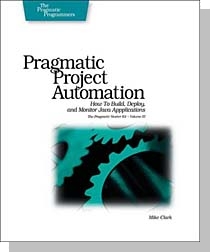
Forget wizards, you need a slave - someone to do your repetitive, tedious and boring tasks, without complaint and without pay, so you'll have more time to design and write exciting code. That's what computers are for: you can enlist your computer to automate all of your project's repetitive tasks, ranging from individual builds and running unit tests through to full product release and customer deployment. Instead of trying to do it by hand - and risk doing it differently or just plain wrong - you can turn these labor-intensive, boring and potentially risky chores into automatic, background processes that just work. This eagerly anticipated book covers a variety of popular, free tools to help automate your project. Armed with plenty of examples and pragmatic advice, you'll find it's easy to get started and reap the benefits of modern software development. You can begin enjoying pragmatic, automatic, unattended software production that's reliable and accurate every time.
The Pragmatic Programmer Starter Kit
В 1999 году была выпущена книга The Pragmatic Programmer: From Journeyman to Master, ставшая удачным введением в современный процесс разработки ПО. С тех пор прошло много времени, и, следуя пожеланиям читателей, издательство The Pragmatic Programmers выпустило трехтомник The Pragmatic Programmer Starter Kit:
Pragmatic Project Automation
Прежде всего, для чего нужна автоматизация? Чтобы сэкономить вам время и избавить вас от рутинной работы. "Машина должна работать, человек - думать" (принцип МежБизМаша). Чем больше команда, работающая над проектом, тем больше потери от простоя такой команды из-за разного рода проблем. Автоматизация поможет снизить риск возникновения таких простоев, снизить риск появления ошибок.
Книга предполагает, что вы уже применяете методики, описанные в первых двух томах серии - т.е. используете систему контроля версий и автоматизированное тестирование - в частности, модульное тестирование.
Для чего используется автоматизация? Что можно автоматизировать? Как это сделать? - вот основные вопросы, на которые отвечает книга. Изложение основано на опыте и дает практические рекомендации. В частности, рассматривается:
Важный момент: в книге рассматриваются только бесплатные инструменты.
Несмотря на слово Java в подзаголовке книги, предлагаемая методология легко переносится на платформу .NET. Для упомянутых инструментов существуют их аналоги: Ant - NAnt, CruiseControl - CruiseControl.NET, log4j - log4net.
В целом - отличная книга, полностью раскрывающая тему автоматизации в процессе разработки. Я рад что она вовремя попала мне в руки, и рад рекомендовать ее вам.